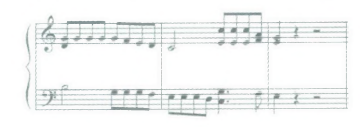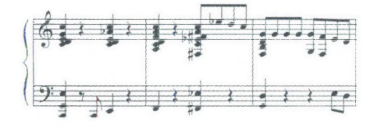I Will Sing unto the Lord
Paul Detterman recently led this song from the piano at a conference, delighting everyone and even making some start dancing in the aisles. He really captured the spirit of celebration and thanksgiving at the mighty power of what God had done. Afterward I asked, “How did you do that?” Here is his response, both a written description of his approach and some musical notes, written to correspond with the context of the service found in the RW article, "The Big Picture." Thank you, Paul!
—ERB
Every church musician knows many reasons why congregational singing is important. Along with everything else, however, we must always remember that when believers sing God’s praise together the result can be just plain fun! That is the inspiration for these settings of the Israeli folk tune tzana (“I Will Sing unto the Lord”).
The initial text provided here recalls the saving power of God in the Exodus. The rhythm and melodic line of the melody suggest an exuberance that comes from being astonished by grace. Said another way, we can guess that Moses and Miriam, standing in safety on the far shore of the Sea of Reeds, didn’t rally the redeemed into an Edwardian hymn at q = 60!
This delightful tune is the “antiphon” or “refrain” suggested for use in a presentation of the full story of redemption (see "The Big Picture"). Relating the Passover to the Lord’s table and the Red Sea waters to the font is exegesis usually left to biblical and liturgical commentaries. Here, the resident musician becomes the on-site commentator and the biblical story comes to life, incarnate in the worshiping congregation. How fun is that!
Accompaniment serves the text. The “changeable” portion of this text is the third line, and the spirit of that line, and the biblical account it recalls, suggest appropriate styles (see p. 39 for these “changeable lines”). Progression through the biblical narrative reveals the scope of God’s provision for his beloved people. The accompaniment can bring this biblical reality to life. Non-negotiable throughout this complete setting is a sense of overwhelming joy. Smile before you start this piece!
- “. . . the horse and rider thrown into the sea . . .”

Since this is the first time through the text and the tune, the congregation’s comfort is of primary concern. Accompaniment should be clear and supportive, setting the spirit of the piece, but also introducing the melody in a clear and encouraging way. Interpretation of the “horse and rider” can be most effective during vocal rests.
- “. . . the fire fell from heaven, don’t you see?”

Again, using the vocal rests, suggest the awe of fire falling to consume the altars of Baal—perhaps with large, descending, somewhat unpredictable chords.
- “. . . he gave a Lamb to save us wondrously . . .”
We need to shift from awe to wonder. This transition must be made in the introduction, suggesting a less aggressive dynamic without losing the drive of the established tempo. Most people will be familiar with the shape of the melody by now, so more can be done “under” the singing.
- “. . . and now we hear him calling, ‘Follow me . . .’”

The “hear him calling” and “follow me” texts provide irresistible incentive to build echo into the accompaniment. The melodic line viciously resists becoming a canon, but hints of the melody, carefully woven into the keyboard part, can give the same effect.
- “. . . the grave is empty, won’t you come and see?”

Now is a good time to revive the unabashed joy of the first stanza. In the light of the resurrection, even the escape through the sea can seem tame! It’s important to remember, however, that this is still a folk song. More dynamic power comes through rhythmic nuance than through fistfuls of notes and faux fanfares!
- “. . . for he will reign in heaven eternally . . .”

The ultimate victory of the kingdom of God is the Christian’s greatest joy. There is great power in a cappella singing punctuated by rhythmic support, especially on the first two lines. After that, nothing you can do would be too far over the top.
No matter how you decide to accompany this fun little folk song, make sure you know where you are going and how you are getting there before you lead the singing in worship. The best improvisation and accompaniment disappears into the fabric of the singing, leaving worshipers wondering why that piece was so much fun. Enjoy!
Los magos que llegaron a Belén/The Magi Went to Bethl’hem Long Ago
This popular Puerto Rican carol for Christmas and Epiphany offers opportunity for children and choirs to lead the congregation and to add flavor and delight with many hand percussion instruments. This carol is often sung in Puerto Rico by carolers who stroll from house to house.
The text of the introduction bridges the distance between the Magi who “announced the promised birth of the Messiah” with our own call to tell the news again today. A few weeks before Christmas, teach this introduction to a group of children and have them sing it from memory before the main part of the carol begins. The introduction can be sung at a deliberate pace, slower than the verses. Keep the instrumentation very simple, with only keyboard and/or guitar.
The main part of the carol is in the style of a traditional Puerto Rican dance. After the introduction, the chord with the fermata allows the next group to get ready to add their part, and the “dance” is ready to begin. Perhaps a two-part children’s choir can sing the “travel music” of the next eight measures. This is the time to add the hand percussion instruments (see p. 37). Also add a bass guitar if possible, beginning with the downbeat before the voices come in. Describe for the children how the pattern in the bass line depicts the uneven gait and even the hump of the camel’s back. Make the most of this travel music, keeping a steady “walking” tempo, not fast, but befitting the dignity of the Magi; perhaps around q = 60.
If you have many resources, you might even want to consider different choirs or groups on the different stanzas; like the old carol “We Three Kings,” the stanzas concentrate on the gifts, with their intimations of the future suffering of the Christ. Perhaps have all the children sing stanza 1, telling of the purpose of their travel and seeking; then have different groups sing stanza 2 (gold), stanza 3 (frankincense), and stanza 4 (myrrh).
The estribillo or refrain adds the “glory to God” song of the angels; have the whole congregation sing the refrain.
The Leaders’ Edition of Sing! A New Creation offers good practice patterns for young (or older!) percussionists. The patterns are accompanied by little Spanish phrases you can practice at the same time; they are simply exercises (café con pan means “coffee with bread”).
Here are a few more ideas from the Leader’s Edition: Use as a processional or offertory during Christmas or Epiphany. Have the children process to the front, placing gifts on a table (including flowers or offertory plates or anything else appropriate).
Shine on Me
The apostle John is often called the apostle of light; he loved the theme of Christ as the light of the world. The word light is found six times just in the opening nine verses of the gospel of John. One of the most frequent calls to confession comes from 1 John 1:5, 7: “God is light, and in him there is no darkness at all. . . . If we walk in the light as he himself is in the light, we have fellowship with one another, and the blood of Jesus his Son cleanses us from all sin.”
The theme of light is also the dominant theme of Epiphany, when we remember the star that led the Magi to the Christ child. In addition to all the joy of the celebration of the Incarnation, it is also appropriate to remember that the light was needed because darkness is all too much a part of our lives and our world. We need the light because darkness continues to try to extinguish the light. So in addition to the carols, consider this as a song of confession, perhaps singing it each week during Advent or during Epiphany.
“Shine on Me” is a fervent prayer that the light of Christ would shine “through the darkness of my heart.” The song is cast in first person, a humble prayer of confession admitting that each of us struggles, but in the context of a covenant relationship with God. The welcome appearance of covenant—both word and concept—helps this prayer of confession become a response of trust and commitment to the God who always keeps covenant with us; we struggle with darkness, but in the confidence that it will never overcome the light (John 1:5). The covenant reference also commends this song for any covenant renewal service, for the beginning of a new year (for example see "New Every Morning") or during the Lord’s Supper.
Here is a way to introduce this song in increments, helping the congregation learn it easily and providing a bit of variety to keep the song fresh each week during a season of singing it.
- The first week, sing only the refrain, repeated after sections of a spoken prayer of confession. The text of the stanzas could even be read as that spoken prayer.
- The second week, have a soloist or choir sing the stanzas.
- The third and fourth weeks, have the congregation sing it all. By that time, encourage everyone (especially the choir) to sing at least the refrain from memory.
“Shine on Me” has a Southern blues flavor, with syncopation and many anticipations; the very first measure sets the flavor with the word me on an “anticipation”—a musical term for reaching the note a bit early, on the eighth note rather than on the downbeat of the next measure. For musical leadership, consider only the piano, with the chromatic blues character as written, but with improvisation welcome. Sing with a slow but steady and firm pulse, about h = 52.
“Shine on me” was written by Richard Carlson, pastor of Roseville Covenant Church in Roseville, Minnesota; he has always loved composing and arranging. He is also known for the children’s video series “Quigley’s Village.”

